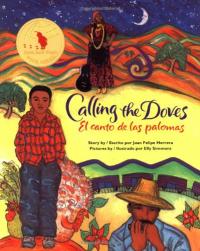
Calling the Doves is poet Juan Felipe Herrera’s story of his migrant farmworker childhood. In delightful and lyrical language, he recreates the joy of eating breakfast under the open sky, listening to Mexican songs in the little trailer house his father built, and celebrating with other families at a fiesta in the mountains. He remembers his mother singing songs and reciting poetry, and his father telling stories and calling the doves.
Calling the Doves

Amelia’s Road

Peace, Locomotion

We Had a Picnic This Sunday Past

When Ada Ruth’s mother goes to Chicago for a much-needed job during World War II, Ada Ruth stays with her grandmother in Grandma’s rural home. Being apart is tough even though Ada Ruth knows it is in response to the war. Words and illustration combine to present a stirring portrait of longing, family, and love until mother and child are reunited.
Coming on Home Soon

Sophisticated readers will appreciate the sly humor and wordplay in the “kissin’ cousin of haiku.” Senyru focuses on everyday activities (e.g., “Freedom vanishes, as the babysitter arrives… kids are tied in nots”) complemented here by comic illustrations.
Wing Nuts: Screwy Haiku

A range of forest inhabitants are presented imaginatively in a variety of poetic styles. From the “Bucktoothed Cleaver” (a beaver) to the chipmunks that invest in the “Acorn Savings Bank,” poetry and illustrations allow readers to see animals afresh.
A Whiff of Pine, a Hint of Skunk: A Forest of Poems

Children everywhere enjoy similar things, celebrated here in rhymes from around the world. Some are traditional while others are by credited authors; each is accompanied by soft illustrations until it’s time to say good night (in many languages).
Rhymes Round the World

Dazzling watercolors turn Hughes’ short poem into an unforgettable glimpse of African American history and an emotional journey through time. A concluding note details the illustrator’s personal connection to the classic poem.
The Negro Speaks of Rivers

The team who created A Kick in the Head (opens in a new window) presents another appealing collection of poems in varied forms and from different time periods. All these poems shout to be shared aloud while illustrations deserve multiple looks.
Foot in the Mouth: Poems to Speak, Sing, and Shout

A predictable rhyme leads from one baby animal to another until a child and his mama kiss “in the honey-sunny day, in the bright and breezy air.” The lively language uses lots of onomatopoeia and soft illustrations that are just right for sharing aloud.
Flip, Flap, Fly! A Book for Babies Everywhere

This handsome book is presented as though the notebook of a birder. It combines haiku, information about birds, and realistic watercolors with notes. Additional brief comments conclude a book that is sure to spark continued interest.
The Cuckoo’s Haiku and Other Birding Poems

Luminous illustrations brighten up each month of the year in this brief but evocative jaunt. The seasons come to life through rhythmic language and translucent images that beg to be shared aloud.
Calendar

Recognizable sibling relationships and associated emotions come alive in dynamic poems and realistic watercolor illustrations. As irritating as brothers and sisters can be, “…I’d rather have them, than not.”
Brothers and Sisters: Family Poems

Lyrical language and textured collages poetically convey the wonder of patterns and shapes in moths, birds, and other creatures. A brief note concludes this handsome volume.
Bees, Snails and Peacock Tails
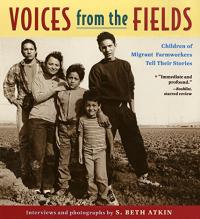
Voices from the Fields: Children of Migrant Farmworkers Tell Their Stories

Return to Sender
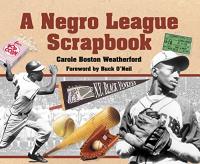
This brief, often poetic, and informative introduction to the Negro Leagues uses period photographs to enhance the information. The period in American history is one of segregation and sadness but also of great joy and achievement.
A Negro League Scrapbook
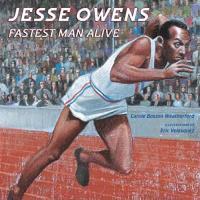
Jesse Owens: Fastest Man Alive
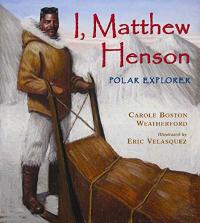
I, Matthew Henson
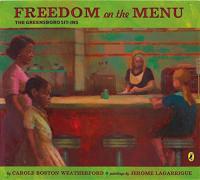
A girl and her mom want to have a sweet treat on a hot day but cannot sit at the soda fountain simply because they are “colored.” Impressionistic paintings soften the harshness of the story of segregation in the South during a turbulent time.
Freedom on the Menu: The Greensboro Sit-Ins
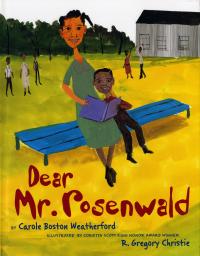
A 10 year old girl narrates this fictionalized story, based on real events and people, of how her rural southern town builds a new school for African American children with the help of Julius Rosenwald (then president of Sears Roebuck).
Dear Mr. Rosenwald
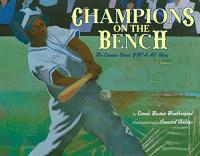
Champions on the Bench

This story is an excerpt from The Circuit and is based on the experiences of the author as the child of migrant farmworkers. Both English and Spanish versions available.
